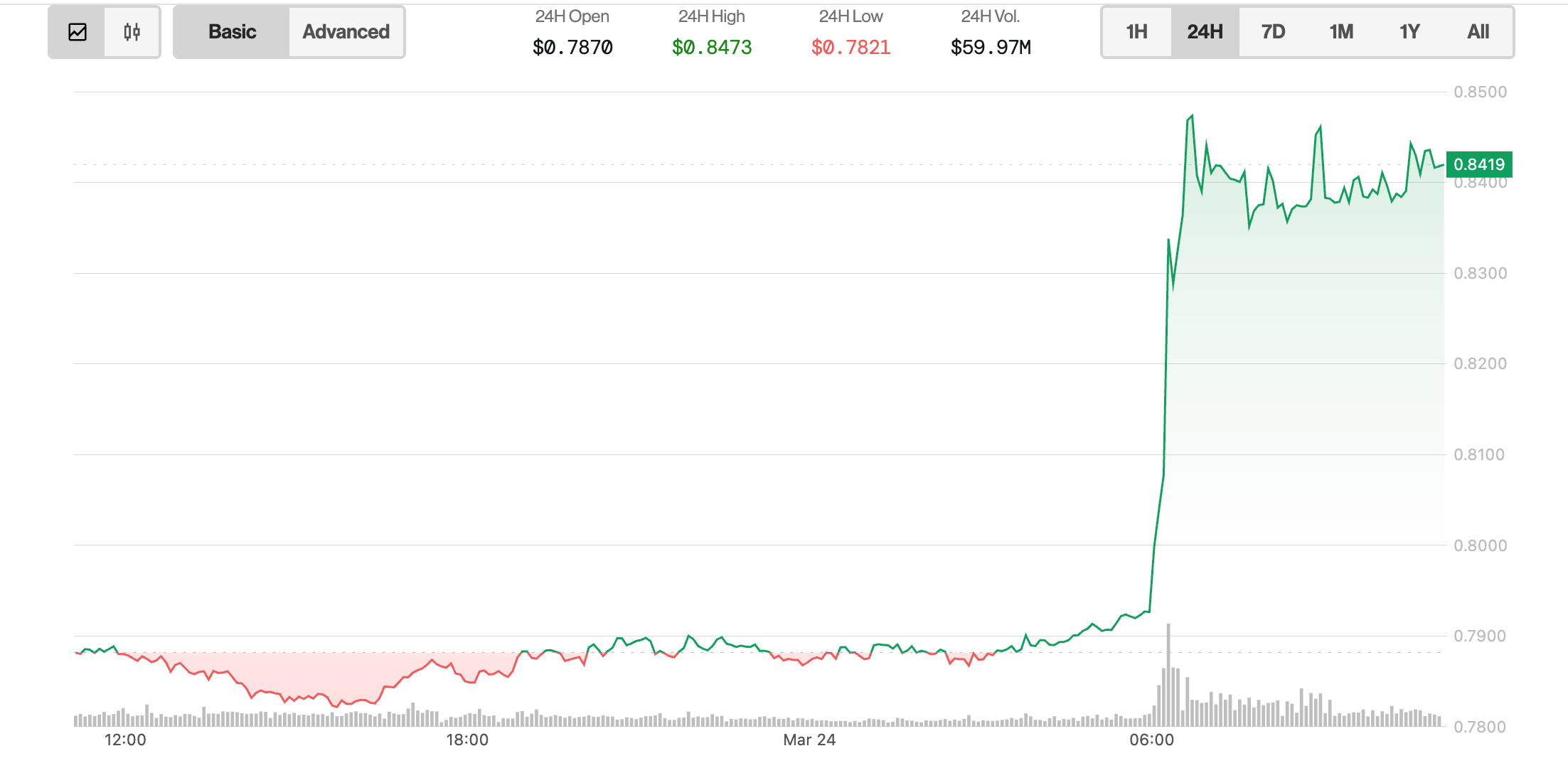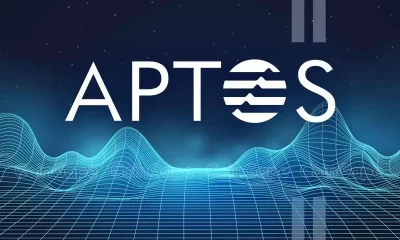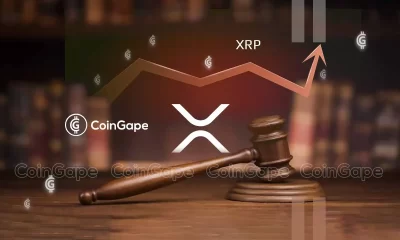Blockchain
Steem Dollars spike 106%, highlighting resurgent interest
Published
3 months agoon
By
admin
Steem Dollars, the stablecoin native to the Steem blockchain, has seen a remarkable price surge of over 106%, drawing fresh attention to the decentralized content and rewards platform.
Originally created in 2016 by blockchain entrepreneur Ned Scott and BitShares founder Dan Larimer, Steem Dollars (SBD) were designed to provide stability in the volatile world of cryptocurrency while powering a unique ecosystem of social media and content creation.
Its market cap currently hovers just above $47.5 million.

The coin’s recent rally highlights renewed interest in the Steem ecosystem, where Steem Dollars play a central role. Pegged to the U.S. dollar, the coin offers a relatively stable cryptocurrency option — integral to the platform’s reward system.
Additionally, Steem – like most cryptocurrencies – can also be used to make digital peer-to-peer payments.
Users earn SBD for publishing and curating content on platforms like Steemit, a New York-based startup that touts itself as a decentralized alternative to traditional social media networks.
Why Steem Dollars matter
SBD provides liquidity for transactions within the Steem blockchain and can be used to earn interest as part of a decentralized savings account. It is also convertible to other cryptocurrencies or fiat.
Additionally, Steem Dollars can be traded for STEEM tokens or Steem Power, the latter increasing influence and voting weight on the platform.
The sharp price increase, however, raises questions about its stability. While the token is intended to maintain a value close to 1 USD, its market-driven price has occasionally deviated from this peg.
The current surge might reflect speculative trading rather than organic growth in the ecosystem, but it nonetheless underscores the enduring relevance of Steem Dollars in the blockchain space.
Looking ahead
As SBD continues to climb, analysts and community members will be watching closely to see if this momentum translates into lasting growth for the Steem ecosystem.
Whether the surge is a fleeting speculative event or the start of a broader renaissance, one thing is clear: Steem Dollars are once again making waves in the cryptocurrency world.
Several platforms integrate stablecoins into reward ecosystems to incentivize user participation and provide stability. Examples include Hive Dollar on the Hive blockchain, offering rewards for content creators, and DAI from MakerDAO, widely used in DeFi for staking and liquidity rewards.
Binance USD (BUSD) and USDC are commonly utilized in platforms like PancakeSwap and PoolTogether for similar purposes. Curve Finance employs stablecoins like DAI and USDT in liquidity pools, while sUSD from Synthetix powers synthetic asset trading and staking rewards.
Social media platforms like Roll and Rally also incorporate stablecoins to reward creators. These ecosystems highlight the versatility of stablecoins in reducing volatility and fostering user engagement.
Source link
You may like


MELANIA Insider Hayden Davis Selling Millions of Dollars Worth of Memecoin Amid 95% Drop: On-Chain Data


Toulouse starts to accept crypto for public transport


Bitcoin, Crypto Prices Slide as Trade Tensions, Inflation Risks Rattle Markets


Will BlackRock Investors Stay Bullish?


Bitcoin Could Appear on 25% of S&P 500 Balance Sheets by 2030, Analyst Says


Centralization and the dark side of asset tokenization — MEXC exec
Bitcoin
BTCFi: From passive asset to financial powerhouse?
Published
13 hours agoon
March 30, 2025By
admin
Disclosure: The views and opinions expressed here belong solely to the author and do not represent the views and opinions of crypto.news’ editorial.
Bitcoin (BTC) has always been the face of crypto, the first thing that comes to mind when you think of this market. But for years, its role has been largely static—held as a store of value, yet rarely used for anything else. Then BTCFi entered the scene: unlike traditional DeFi, which has been dominated by Ethereum (ETH) and other smart contract platforms, BTCFi is built around Bitcoin as the core asset.
In the last quarter of 2024, BTCFi’s total value saw a massive surge—from $800 million all the way to $6.5 billion. The momentum is impressive, to say the least. More institutional players are taking notice, and analysts predict that by 2030, roughly 2.3% of Bitcoin’s circulating supply (about $47 billion) could be actively used in decentralized finance.
So clearly, BTCFi is not just a passing trend. But why is it gaining so much traction? Can it really be called the future of Bitcoin’s utility as a financial asset?
Let’s try to figure it out.
What is BTCFi, and why is it growing now?
BTCFi represents the intersection of Bitcoin and decentralized finance, with the first crypto playing the role of the core asset in this case. Typically, DeFi platforms have been built on blockchains like Ethereum, while Bitcoin holders had to wrap their BTC into ERC-20 tokens (like wBTC) to participate in this field.
This kind of tokenization started picking up the pace around 2020, allowing BTC holders to access DeFi services that are typically not available on the Bitcoin blockchain. These “wrapped” tokens are built in a way that makes them compatible with other blockchain networks. And so, they effectively extended Bitcoin’s functionality.
However, advancements in Bitcoin L2 solutions and LRTs, or layered rollup technologies, are now changing the rules. It is becoming unnecessary for Bitcoin to use “second class citizen” ERC-20 tokens anymore.
BTC LRTs, for example, operate on Ethereum and other chains as well, but use Bitcoin as the primary collateral in transactions. This means unlocking the use of Bitcoin as a yield-generating asset in other networks beyond its native chain.
The emerging Bitcoin L2s, meanwhile, are tackling this blockchain’s long-standing scalability issues, allowing for faster and more cost-efficient transactions. These innovations are going to fundamentally redefine Bitcoin, turning it from a passive store of value to an actively utilized financial asset.
Why is BTCFi the gateway for Bitcoin whales in 2025?
Large Bitcoin holders—miners, in particular—have often used CeFi loans backed by their BTCs to fund their operations since they didn’t want to outright sell those assets. This practice is still going on today, but BTCFi promises to make some changes. And that’s where everything will start from, really: by BTCFi enabling new opportunities for Bitcoin holders to put their assets to work.
Soon enough, Bitcoin whales will start looking at BTCFi as a powerful gateway that can be used to enter the DeFi space. And the way I see it, there are two key factors in 2025 that will influence that perception.
The first is the rise of Bitcoin ETFs. BTC ETFs currently account for almost 6% of all Bitcoin supply, having crossed $100 billion in holdings at the beginning of 2025. With them gaining mainstream traction, Bitcoin is increasingly perceived as the safest and most stable cryptocurrency asset.
This makes it a prime choice for DeFi, attracting large-scale holders who want to use their BTC without selling. Earlier in February this year, Goldman Sachs announced that it had invested $1.63 billion in Bitcoin ETFs. That’s easy proof right there.
The second major factor is the appearance of BTC L2 technologies, which we’ve already covered earlier. Until recently, the lack of scalability and transaction efficiency held Bitcoin back from DeFi adoption. Now, we are going to see a surge of L2 solutions that will enhance the network’s performance. And here’s the important part: they will do so while preserving Bitcoin’s core principles of decentralization and simplicity (and, hence, its robustness).
What DeFi platforms need to do for proper BTCFi integration
There are several challenges that will need to be overcome before BTCFi can achieve truly seamless integration. The biggest technical issue will be ensuring that Bitcoin-based L2 solutions become genuinely trustless. At the present time, they are not quite there, often relying on intermediaries and centralized elements, which goes against Bitcoin’s core philosophy.
The good news is that there’s a lot of R&D going on to make it happen. If successful, it could make the vast amounts of BTCs that are currently just lying there “collecting dust” be useful in DeFi.
Another big challenge is going to stem from people’s trust. Among Bitcoin holders, there are many who do not quite trust Ethereum and the existing Bitcoin tokenization methods. The key to winning them over will lie in creating robust and cost-effective solutions on the native Bitcoin network. Having a fully trustless and inexpensive execution layer on the BTC blockchain could really become the dealbreaker for these people.
The future of Bitcoin: More than just ‘digital gold’
For years, Bitcoin has been carrying the moniker of “digital gold”—a safe-haven asset meant for holding rather than using. These days, this is becoming increasingly untrue. As more institutional players enter the crypto space, the potential for BTCFi to become Bitcoin’s next-level evolution is very real.
The demand is on the rise, and the infrastructure is already being built. For Bitcoin whales looking to maximize their assets without selling, BTCFi could become the perfect answer.
Disclosure: This article does not represent investment advice. The content and materials featured on this page are for educational purposes only.

Michael Egorov
Michael Egorov is a physicist, entrepreneur, and crypto maximalist who stood at the origins of DeFi creation. He is a founder of Curve Finance, a decentralized exchange designed for efficient and low-slippage trading of stablecoins. Since the inception of Curve Finance in 2020, Michael has developed all his solutions and products independently. His extensive scientific experience in physics, software engineering, and cryptography aids him in product creation. Today, Curve Finance is one of the top three DeFi exchanges regarding the total volume of funds locked in smart contracts.
Source link
Blockchain
PwC Italy, SKChain to launch self-sovereign EU digital ID
Published
7 days agoon
March 24, 2025By
admin

PwC Italy and blockchain consultancy SKChain Advisors are developing a digital identity solution for the European Union using blockchain technology.
The product, built on the World Mobile Chain, a Layer 3 network on Coinbase’s Base, aims to provide a secure, self-sovereign identity framework that allows users to control their personal data without relying on centralized authorities.
The initiative aligns with the European Digital Identity Wallet introduced under the eIDAS 2.0 regulation, which aims to standardize digital identity across the EU, according to a press release shared with crypto.news.
PwC Italy and SKChain Advisors have completed a feasibility study to determine the optimal SSI framework and are now moving forward with development.
The solution will act as a gateway for users to access both traditional and Web3 platforms.
Data privacy and security
SSI technology is gaining traction as a way to enhance data privacy and security while complying with regulations such as the EU’s Markets in Crypto-Assets framework.
According to a company note, the new digital identity product will support authentication, verification, and interactions with digital asset services.
This is expected to help enterprises and consumers navigate an increasingly digital economy while ensuring compliance with evolving regulatory standards.
“There has been talk for a long time about whether the EU’s digital identity scheme would use blockchain,” Rob Viglione, CEO of Horizen Labs told crypto.news. “The fact this has been confirmed is a positive step forward. The fact it’s using self-sovereign identity technology is also a positive step.”
World Mobile Chain, the infrastructure supporting the project, is designed to facilitate blockchain adoption among European businesses. As a Layer 3 protocol on Base, it provides scalability and efficiency for decentralized applications.
The digital ID solution will allow companies to implement blockchain-powered identity verification without compromising privacy.
Viglione emphasizes the importance of privacy in digital identity systems, stating that: “Users need privacy and security guarantees. Any digital ID scheme should be using zero-knowledge proof technology to ensure data remain ‘usable but invisible.’”
The product is expected to streamline digital access across various sectors while giving users greater control over their online identities.
Source link
Blockchain
Trump-Linked WLFI Snaps Up 3.54M MNT After Last Week’s Hard Fork
Published
7 days agoon
March 24, 2025By
admin

World Liberty Financial (WLFI), a DeFi project backed by President Donald Trump’s family, has acquired substantial amounts of Mantle’s MNT token following last week’s major technological upgrade of the network.
WLFI purchased about 3.54 million MNT for nearly $3 million USDC for an average purchase price of 84 cents, according to data sources Lookonchain and Arkham Intelligence.
The recent purchase has increased WLFI’s coin holdings, which include tokens like ETH, WBTC, TRX, LINK, AAVE, ENA, and others, to over $340 million. However, the Trump family-backed outlet still faced a paper loss of $111 million as of writing.
MNT is the native cryptocurrency of the Mantle Network, serving as a utility token for gas fees and a governance token for the layer 2 ecosystem focused on scaling Ethereum.
The Mantle Mainnet hard fork, or backwards-incompatible upgrade, took effect on March 19, activating EigenDA on the network. EigenDA is a secure, high-throughput, decentralized data availability service on Ethereum.
The EigenDA integration is said to boost Mantle Network’s scalability without hitting data rate limits, reportedly resulting in a 15 MB/s throughput. In other words, the network can process more transactions per block. Additionally, the upgrade has made the Mantle Network better compatible with Ethereum’s impending Pectra upgrade.
MNT traded at 6% higher on the day at 83 cents at press time, according to data sources CoinDesk and TradingView.
Source link

MELANIA Insider Hayden Davis Selling Millions of Dollars Worth of Memecoin Amid 95% Drop: On-Chain Data

Toulouse starts to accept crypto for public transport

Bitcoin, Crypto Prices Slide as Trade Tensions, Inflation Risks Rattle Markets

Will BlackRock Investors Stay Bullish?

Bitcoin Could Appear on 25% of S&P 500 Balance Sheets by 2030, Analyst Says

Centralization and the dark side of asset tokenization — MEXC exec

Bitcoin Support Thins Below $78,000 As Cost Basis Clusters Shift Toward $95,000

Cryptocurrencies to watch this week: Solana, Cronos, DOT

EU Regulator Pushes for New Capital Rules for European Insurers Holding Crypto Assets

Japan Set To Classify Cryptocurrencies As Financial Products, Here’s All

This Week in Crypto Games: ‘Off the Grid’ Token, GameStop Goes Bitcoin, SEC Clears Immutable

Binance debuts centralized exchange to decentralized exchange trades

Why Is the Crypto Market Down Today? Bitcoin Drops to $82K as Traders Flee Risk Assets Amid Macro Worries

BTCFi: From passive asset to financial powerhouse?

Hyperliquid Delists $JELLY, Potentially Causing $900K in Losses. Here’s Why Best Wallet Token Can 100x

Arthur Hayes, Murad’s Prediction For Meme Coins, AI & DeFi Coins For 2025

Expert Sees Bitcoin Dipping To $50K While Bullish Signs Persist

Aptos Leverages Chainlink To Enhance Scalability and Data Access

Bitcoin Could Rally to $80,000 on the Eve of US Elections

Sonic Now ‘Golden Standard’ of Layer-2s After Scaling Transactions to 16,000+ per Second, Says Andre Cronje

Institutional Investors Go All In on Crypto as 57% Plan to Boost Allocations as Bull Run Heats Up, Sygnum Survey Reveals

Crypto’s Big Trump Gamble Is Risky

Ripple-SEC Case Ends, But These 3 Rivals Could Jump 500x

Has The Bitcoin Price Already Peaked?

A16z-backed Espresso announces mainnet launch of core product

Xmas Altcoin Rally Insights by BNM Agent I

Blockchain groups challenge new broker reporting rule

The Future of Bitcoin: Scaling, Institutional Adoption, and Strategic Reserves with Rich Rines

Trump’s Coin Is About As Revolutionary As OneCoin

Is $200,000 a Realistic Bitcoin Price Target for This Cycle?
Trending

 24/7 Cryptocurrency News5 months ago
24/7 Cryptocurrency News5 months agoArthur Hayes, Murad’s Prediction For Meme Coins, AI & DeFi Coins For 2025

 Bitcoin2 months ago
Bitcoin2 months agoExpert Sees Bitcoin Dipping To $50K While Bullish Signs Persist

 24/7 Cryptocurrency News3 months ago
24/7 Cryptocurrency News3 months agoAptos Leverages Chainlink To Enhance Scalability and Data Access

 Bitcoin5 months ago
Bitcoin5 months agoBitcoin Could Rally to $80,000 on the Eve of US Elections

 Altcoins2 months ago
Altcoins2 months agoSonic Now ‘Golden Standard’ of Layer-2s After Scaling Transactions to 16,000+ per Second, Says Andre Cronje

 Bitcoin5 months ago
Bitcoin5 months agoInstitutional Investors Go All In on Crypto as 57% Plan to Boost Allocations as Bull Run Heats Up, Sygnum Survey Reveals

 Opinion5 months ago
Opinion5 months agoCrypto’s Big Trump Gamble Is Risky

 Price analysis5 months ago
Price analysis5 months agoRipple-SEC Case Ends, But These 3 Rivals Could Jump 500x


